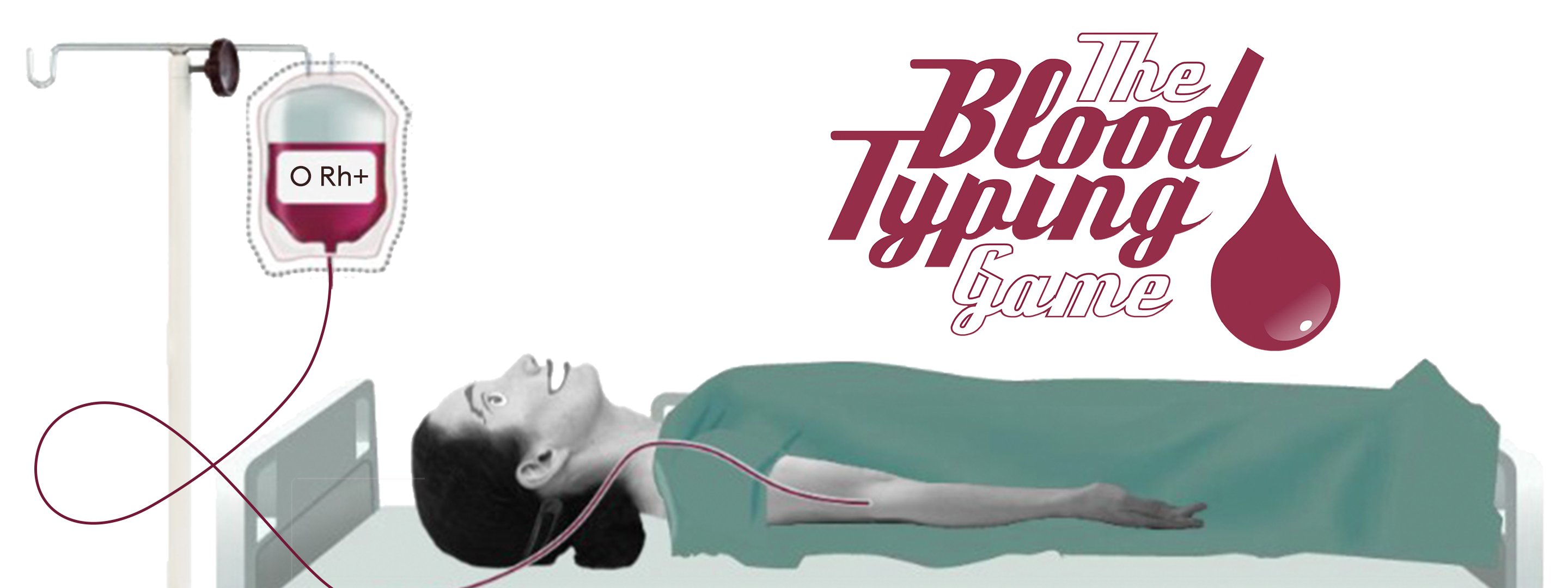
Tutorial 1
What is a blood type?
Before Nobel Prize awarded Karl Landsteiner discovered the ABO human blood groups in 1901, it was thought that all blood was the same. This misunderstanding led to fatal blood transfusions. Later, in 1940, Landsteiner was part of discovering another blood group, the Rh blood group system. There are many blood group systems known today, but the ABO and the Rh blood groups are the most important ones used for blood transfusions. The designation Rh is derived from the Rhesus monkey in which the existence of the Rh blood group was discovered.
What is blood made up of?
An adult human has about 4–6 liters of blood circulating in the body. Among other things, blood transports oxygen to various parts of the body.
Blood consists of several types of cells floating around in a fluid called plasma.
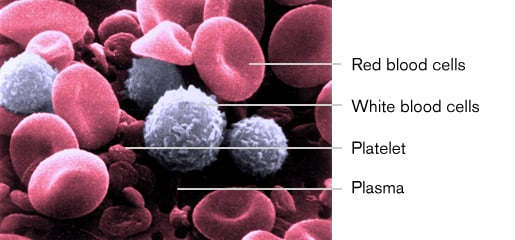
Image source: National Cancer Institute, USA. Photo: Bruce Wetzel and Harry Schaefer
This is a scanning electron microscope image of human blood.
The red blood cells contain hemoglobin, a protein that binds oxygen. Red blood cells transport oxygen to, and remove carbon dioxide from, the body tissues.
The white blood cells fight infection. One type of infection-fighting white blood cells fight disease by producing antibodies and thus destroying foreign materia.
The platelets help the blood to clot, if you get a wound for example.
The plasma contains salts and various kinds of proteins.
How do the blood types differ?
Our blood types are determined by heredity. People belong to either of eight different blood types:
A Rh+, A Rh-, B Rh+, B Rh-, AB RH+, AB Rh-, 0 Rh+, or 0 Rh- .
The eight blood types have different combinations of certain molecules, antigens, on the surface of the red blood cells. The A and B antigens are sugars and the Rh antigens are proteins. The antigens expressed in the red blood cells determine an individual's blood type.
Also the combination of some other molecules floating around in the blood plasma differs between the eight blood types, the so called antibodies.
You can have A or/and B or/and Rh antigens or none of them.
You can have A or/and B or/and Rh antibodies or none of them.
All eight blood types
Blood type A Rh-
Antigens (on the surface of the red blood cells):
A indicates there are A antigens.
(Rh- indicates there are no Rh antigens)
Antibodies (in the blood plasma):
B antibodies.
Rh antibodies.
(If there are A antigens but no B nor Rh antigens, the antibodies in the blood plasma are B and Rh antibodies.)
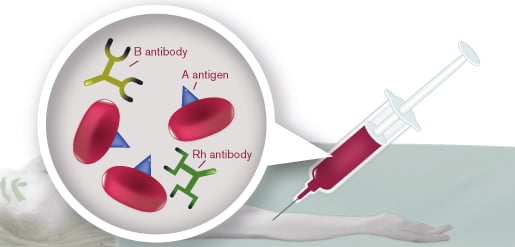
The blood type notation A Rh- indicates which antigens and antibodies are present in the blood.
Blood type A Rh+
Antigens (on the surface of the red blood cells):
A indicates there are A antigens.
Rh+ indicates there are Rh antigens.
Antibodies (in the blood plasma):
B antibodies.
If there are A and Rh antigens but no B antigens, the antibodies in the blood plasma are B antibodies.
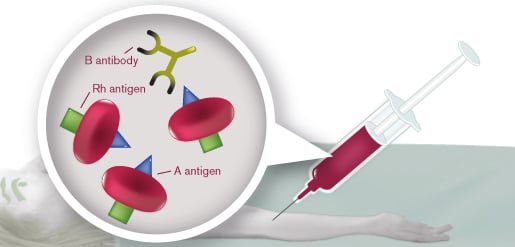
The blood type notation A Rh+ indicates which antigens and antibodies are present in the blood.
Blood type B Rh-
Antigens (on the surface of the red blood cells):
B indicates there are B antigens.
(Rh- indicates there are no Rh antigens.)
Antibodies (in the blood plasma):
A antibodies.
Rh antibodies.
(If there are B antigens but no A nor Rh antigens, the antibodies in the blood plasma are A and Rh antibodies.)
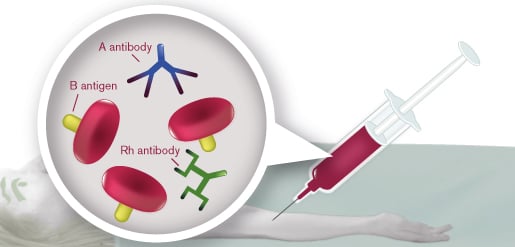
The blood type notation B Rh- indicates which antigens and antibodies are present in the blood.
Blood type B Rh+
Antigens (on the surface of the red blood cells):
B indicates there are B antigens.
Rh+ indicates there are Rh antigens.
Antibodies (in the blood plasma):
A antibodies.
If there are B and Rh antigens but no A antigens, the antibodies in the blood plasma are A antibodies.
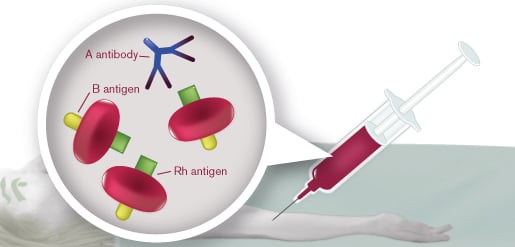
The blood type notation B Rh+ indicates which antigens and antibodies are present in the blood.
Blood type AB Rh-
Antigens (on the surface of the red blood cells):
AB indicates there are both A and B antigens.
(Rh- indicates there are no Rh antigens.)
Antibodies (in the blood plasma):
Rh antibodies.
(If there are A and B antigens but no Rh antigens, the antibodies in the blood plasma are Rh antibodies.)

The blood type notation AB Rh- indicates which antigens and antibodies are present in the blood.
Blood type AB Rh+
Antigens (on the surface of the red blood cells):
AB indicates there are both A and B antigens.
Rh+ indicates there are Rh antigens.
Antibodies (in the blood plasma):
No antibodies!
(If all possible antigens are present, A, B and Rh antigens, there are no antibodies in the blood plasma.)
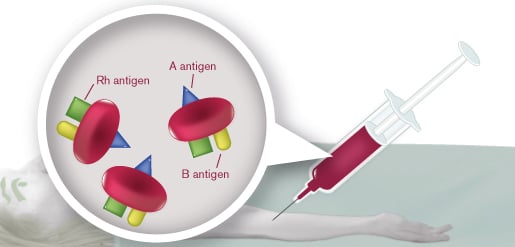
The blood type notation AB Rh+ indicates which antigens and antibodies are present in the blood.
Blood type O Rh-
Type O blood gets its name because it has neither A nor B antigens! In other languages O is often pronounced as "null".
Antigens (on the surface of the red blood cells):
No antigens!
(O indicates there are neither A nor B antigens.)
(Rh- indicates there are no Rh antigens.)
Antibodies (in the blood plasma):
A antibodies.
B antibodies.
Rh antibodies.
(If there are no antigens at all on the surface of the red blood cells, all three possible antibodies are present in the blood plasma: A, B and Rh antibodies.)
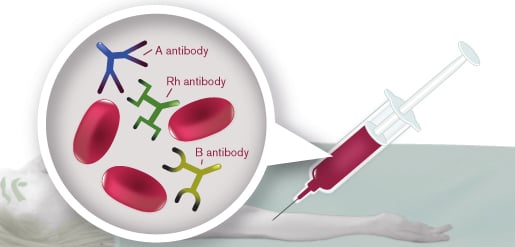
The blood type notation O Rh- indicates which antigens and antibodies are present in the blood.
Blood type O Rh+
Type O blood gets its name because it has neither A nor B antigens! In other languages O is often pronounced as "null".
Antigens (on the surface of the red blood cells):
(0 indicates there are neither A nor B antigens.)
Rh+ indicates there are Rh antigens.
Antibodies (in the blood plasma):
A antibodies.
B antibodies
(If there are Rh antigens but no A nor B antigens, the antibodies present in the blood plasma are A and B antibodies.)
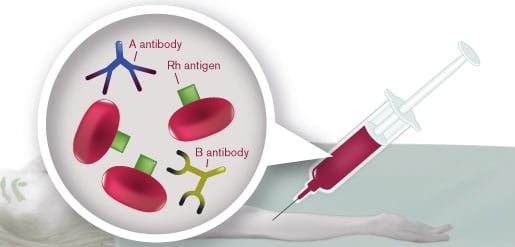
The blood type notation O Rh+ indicates which antigens and antibodies are present in the blood.
Disclaimer:
The fact that people with Rh- blood do not naturally have Rh antibodies in the blood plasma (as one can have A or B antibodies, for instance) is not taken into consideration in this game. In reality a person with Rh- blood can develop Rh antibodies in the blood plasma if he or she receives blood from a person with Rh+ blood. The received blood cells with Rh antigens can trigger the production of Rh antibodies in an individual with Rh- blood. In the game one has to pretend that all patients with Rh- blood type has received Rh+ blood in previous blood transfusions.
Also, the antibodies are here referred to as A antibodies, B antibodies and Rh antibodies. These are also commonly referred to as anti A antibodies, anti B antibodies, and anti Rh antibodies.
MLA style: "The Blood Typing Game - Tutorial 1: What is a blood type?". Nobelprize.org. Nobel Prize Outreach AB 2022. <http://nobel-external-educationalgames-app.azurewebsites.net/educational/medicine/bloodtypinggame/gamev3/1.php>